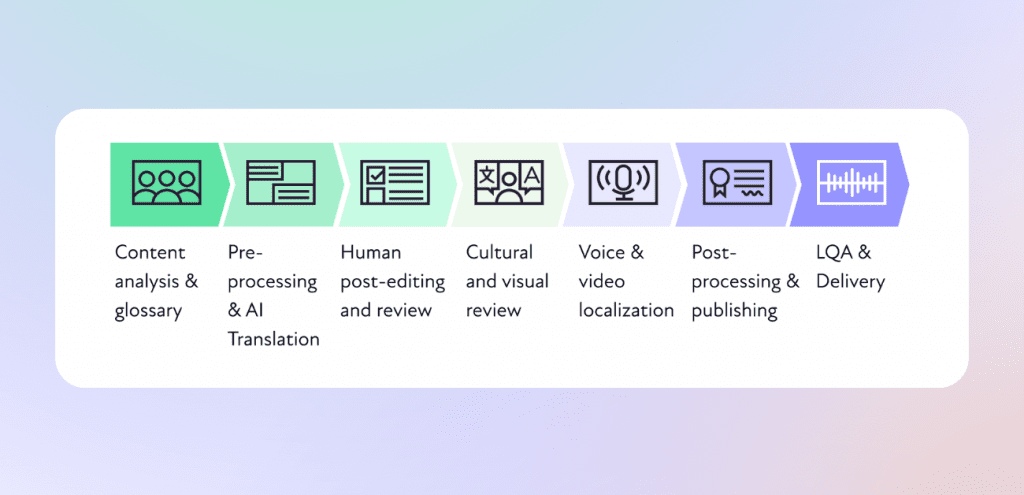Corinne Sharabi
Corinne is the Social Media and Content Lead at BLEND. She is dedicated to keeping global business professionals up to date on all things localization, translation, language and culture.

In today’s global marketplace, businesses are no longer confined by geographical boundaries. Companies of all sizes are reaching out to international audiences, offering their products and services to diverse markets.
However, expanding globally comes with its own set of challenges, especially when it comes to effectively communicating with different cultures. This is where localization management becomes critical. By ensuring consistency and quality across different markets, effective localization management helps businesses expand their reach while maintaining their brand identity and customer satisfaction. It can also increase customer engagement, encourage brand loyalty, and boost sales.
While localization refers to the process of adapting a product for a new region and target market, localization management relates to how that process itself is organized. This includes everything from structuring the localization process to measuring and monitoring the success of a campaign.
Localization management encompasses the planning, execution, and oversight of localization activities. This ensures that all localized content aligns with the original intent and meets the standards of the target market. As well as communicating with translation teams, a localization project manager needs to organize workflows for editors, developers, reviewers, and more.
Localization management is crucial for businesses looking to penetrate new markets and establish a competitive advantage. Here are some key reasons why effective localization management is important:
The localization management process involves several key stages that may look different depending on your company’s product and internal structures. Here is a step-by-step example of a typical localization management process:
When kicking off a new campaign, feature, or product, a localization manager should get involved from the beginning to plan for necessary localization. The process begins by defining the project scope and objectives and identifying target markets and languages which may require research. You’ll also need to assemble a localization team, including project managers, translators, and reviewers, and develop the project’s timeline and budget.
Assess the source content for localization suitability. Chances are that the content will have to be extracted for translation and then replaced with translated content later. Using a good translation management system (TMS) can help you automate the process. When analyzing the content, you’ll want to identify any cultural or technical adaptations required. Creating a translation glossary and style guide is also a key step to ensure consistent terminology and tone across your localization projects.

Assigning qualified translators for each target language is an important step in the localization management process. The right translator makes a big impact on the quality and efficiency of your content’s localization. Leverage translation memory (TM) tools and AI/machine translation (if appropriate) can also increase both consistency and efficiency. When using machine translation for initial drafts, we recommend following up with a human linguist review to avoid quality issues later.
Before a final launch, consider localization testing to flag any bugs and performance issues. Both linguistic and functional testing are key to ensuring accuracy and usability. You’ll also want to review translations for cultural appropriateness and compliance with local regulations. Make sure to address any issues that arise during the QA process before launching your project.
Almost ready to launch your project! Just perform a final check to ensure all content meets quality standards. After releasing your localization project, make sure to update the translation memory and documentation for future reference. Post launch, pay attention to your key performance metrics and check up on what your customers are saying about the localized content.
Before mapping out a team strategy, a localization team should establish its purpose. The team’s efforts and KPIs should align with the business’s overall goals and objectives. It’s also important to note that the user experience should be at the heart of a localization team’s strategy.
“My team has positioned ourselves as the guardians of international users, because as you can imagine, everyone always thinks of English and English users interacting with English content. We have always tried to shift that focus.”
– Stefania Russo, Head of UX Content at Glovo
Along with KPIs and metrics, it is often the localization team’s role to consider the following decisions:
To increase your speed to market and avoid any other setbacks, you’ll want to familiarize yourself with the most common obstacles encountered during localization management.

Are you finding it difficult to determine whether or not your localization efforts are paying off? Chances are, you haven’t been specific enough when outlining your goals. As localization management challenges go, poorly defined goals are one of the more common.
Fortunately, the problem is easily overcome. To make monitoring simple, ensure you’re being as specific as possible when selecting KPIs. Do you have any short-term objectives you wish to achieve? Be as clear as possible when communicating this to your team.

A well-executed localization project is the sum of many parts. A typical localization team is made up of translators, QA specialists, developers, marketers, and more. Keeping all of these people in the loop and updated on project goals can prove difficult.
The good news is that there are plenty of ways to streamline communications. By investing in the right communication and collaboration tools, keeping everyone connected is simple.

One of the most common localization problems is a shortage of talent with the right skills to succeed. It’s a challenge to find professionals with the right expertise, relevant language skills, and cultural insights you need to succeed in a new territory, especially internally.
You can overcome this hurdle by turning to third-party localization services. Companies specializing in localization already have multidisciplinary teams assembled, with essential skill sets well represented.
Gearing up for global expansion, but worried you don’t have the resources you need to pull off a successful localization campaign? Why not get in touch with BLEND today? Our single-source localization platform can be customized to your liking, streamlining everything from talent recruitment and allocation to quality assurance.
Finding it hard to recruit experienced linguists? Our extensive network of vetted translators means you never have to worry about striking the right tone with new audiences. Worried about quality? With our reliable LQA support, quality is guaranteed. What’s more, it’s easy to scale your localization plans thanks to custom APIs and automated workflows.
The localization process can seem like a daunting one. However, effective management is crucial to a successful localization campaign. Localization management can result in massive productivity gains, improve brand consistency, and strengthen quality assurance from start to finish. What’s more, localization management tools can streamline workflows, with automation able to handle many smaller tasks.
Need help selecting a winning localization strategy? Struggling to put together a highly skilled team or simplify your workflows? Bring in the expertise of an established localization services partner like BLEND. We’ll help you shape a strategy that’s in line with your goals, connect you with the best localization professionals in the business, and more.
Ready to reap the rewards of localization? Get in touch with the team today to discuss localization management and our other services.
What our customers are saying